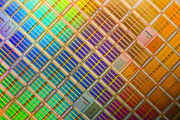A Better Memory Chip
Freescale Semiconductor, a Motorola spinoff, released today the first commercial semiconductor memory that uses magnetic properties to store data. This new type of chip will compete with other established forms of semiconductor memory, such as Flash and random-access memory (RAM). Most engineers believe that the technology, called magnetoresistive random-access memory – or MRAM – could reduce the cost and power consumption of electronics for cell phones, music players, laptops, and servers.

In fact, MRAM has the potential to transform the landscape of electronics devices, says Doug Burger, professor of computer sciences and electrical engineering at the University of Texas in Austin. The Freescale announcement shows that the materials and manufacturing processes are finally – after decades of development – technically and economically feasible. “Technology announcements are very often incremental but this is a big step,” he says.
The fundamental feature that makes MRAM an alluring alternative to other forms of semiconductor memory is the way it stores data. Flash memory and RAM, for example, hold information as electric charge. In contrast, MRAM uses the magnetic orientation of electrons to represent bits.
An MRAM chip is made of hundreds of thousands of memory cells that contain two magnetic electrodes: one electrode’s magnetic field is fixed in place; the other’s can change polarization. The resistance between the electrodes can be high or low, depending on the polarization of the electrodes, and indicates which binary number the cell is storing, a 1 or a 0.
Using the magnetic properties of a material gives a “unique combination of characteristics that you can’t get in any other semiconductor material,” says Saied Tehrani, director of MRAM at Freescale. MRAM chips, he says, hold data without a power supply and can be written to and read from an unlimited number of times. Reading and writing data from MRAM is also fast, taking a matter of nanoseconds.
MRAM is able to hold data without power (a property called “nonvolatility”), because once the magnetic orientation of an electron is set, it doesn’t need electricity to be maintained. This feature makes MRAM a candidate to replace RAM, the easy-access memory found in computers and other devices, says Tehrani. The electrons that hold data in RAM chips lose their place when a computer or cell phone is turned off, effectively erasing previously stored information. This is why more permanent data is stored in nonvolatile memory such as magnetic hard disks in computers and Flash memory in cell phones.
Flash memory is also seen as a potential alternative to RAM because, like MRAM, it might eliminate boot-up time on a computer (see “Starting Your PC in a Flash”). The problem with Flash memory is that one can’t use it forever. It is nonvolatile because the memory cells that store the charge have high barriers that keep the charge from leaking out. In order to overcome these barriers to read and write data, a large electric field is needed, explains Bill Gallagher, research staff member at the IBM Thomas J. Watson Research Center. However, this design creates a problem because over time, large electric fields wear out the material used to store charge in the cells, limiting the number of read-write cycles to around 100,000. In addition, Flash is relatively slow, taking hundreds of nanoseconds to write information. For these reasons, Flash “is not well suited for the sort of writes you do in a computer system,” says Burger.
The properties of MRAM combine the best of Flash memory and RAM. Like RAM, it doesn’t wear out, so it’s better suited than Flash for instant-on computers and other electronics. Additionally, by not needing constant power, it could be used in small devices where battery power is at a premium, from cell phones to millimeter-sized sensors.
It may take a few years, however, for MRAM to completely replace Flash or RAM. Today, Freescale’s MRAM chip can store only four megabits of information, a measly amount compared to Flash memory, which can hold several gigabits.
Increasing the space on an MRAM chip could pose problems. At this point, it’s unknown whether the current MRAM materials and design will be well suited for future MRAM chips with smaller feature sizes. The magnetic fields used to store data in MRAM chips have distinctive shapes, Burger explains, and it’s not clear what adjustments will need to be made to these fields to maintain product quality as the features shrink.
IBM’s Gallagher said that with today’s materials, he thinks it’s possible to increase the storage density by 100-fold. And as research progresses, he says, “we could have [an MRAM] device with the storage capacity of a hard disk drive.”
Keep Reading
Most Popular
Large language models can do jaw-dropping things. But nobody knows exactly why.
And that's a problem. Figuring it out is one of the biggest scientific puzzles of our time and a crucial step towards controlling more powerful future models.
The problem with plug-in hybrids? Their drivers.
Plug-in hybrids are often sold as a transition to EVs, but new data from Europe shows we’re still underestimating the emissions they produce.
Google DeepMind’s new generative model makes Super Mario–like games from scratch
Genie learns how to control games by watching hours and hours of video. It could help train next-gen robots too.
How scientists traced a mysterious covid case back to six toilets
When wastewater surveillance turns into a hunt for a single infected individual, the ethics get tricky.
Stay connected
Get the latest updates from
MIT Technology Review
Discover special offers, top stories, upcoming events, and more.